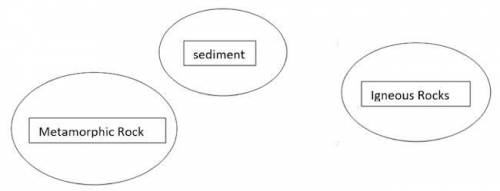
Biology, 15.03.2020 02:17 hailiemanuel3461
One student made the incomplete diagram shown below to represent the relationship between sediment, igneous rocks, and metamorphic rocks:
Which of these is the correct next step to complete the diagram? (4 points)
Put an arrow labeled heat and melt, pointing from igneous rocks to sediment.
Put an arrow labeled deposition and lithification, pointing from metamorphic rock to sediment.
Put an arrow labeled cools and crystallizes, pointing from igneous rocks to sediments.
Put an arrow labeled heat and pressure, pointing from sediment to metamorphic rock.


Answers: 3
Another question on Biology

Biology, 22.06.2019 00:00
Does masterbation affect height growth or loss of growth hormone?
Answers: 2

Biology, 22.06.2019 02:00
Which statement correctly describes a way that mutations increase the likelihood that a species will survive in a changing environment
Answers: 1

Biology, 22.06.2019 05:40
Benito is doing research on the effects of florida's elevation on its climate. his notes include the following: 1. the average elevation of florida is 30 m above sea level. 2. the highest point in florida is britton hill, which is 105 m above sea level. 3. the change in temperature from 0 m to 1,000 m is 7 °c. what can benito conclude about the effects of florida's elevation on its climate? a.) florida typically experiences cold temperatures and temperature changes within a narrow range. b.) florida typically experiences cold temperatures and temperature changes within a broad range. c.) florida typically experiences warm temperatures and temperature changes within a narrow range. d.) florida typically experiences warm temperatures and temperature changes within a broad range.
Answers: 1

Biology, 22.06.2019 14:30
What is a difference between systemic and pulmonary circulation? a. systemic circulation carries oxygenated blood to the lungs and pulmonary circulation carries deoxygenated blood to the body. b. systemic circulation carries deoxygenated blood to the lungs and pulmonary circulation carries oxygenated blood to the body. c. systemic circulation carries deoxygenated blood to the body and pulmonary circulation carries oxygenated blood to the lungs. d. systemic circulation carries oxygenated blood to the body and pulmonary circulation carries deoxygenated blood to the lungs.
Answers: 1
You know the right answer?
One student made the incomplete diagram shown below to represent the relationship between sediment,...
Questions




Spanish, 10.03.2021 18:10


Mathematics, 10.03.2021 18:10

Mathematics, 10.03.2021 18:10

Chemistry, 10.03.2021 18:10

Social Studies, 10.03.2021 18:10

Mathematics, 10.03.2021 18:10








Chemistry, 10.03.2021 18:10


SAT, 10.03.2021 18:10



